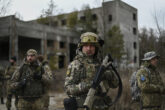January 21, 2020
Interservice rivalries: A force for good
It’s no secret that the military services fight hard to protect their shares of the defense budget. Just last week, Chief of Naval Operations Adm. Michael Gilday made his case for a greater share of the defense budget. Army Secretary Ryan McCarthy quickly answered, making the same claim on behalf of his service. What if the Department of Defense were able to use these rivalries as a force for good? The secretary of defense should pit the services against each other in a healthy competition for solutions to real operational challenges. The reward? More funding in their budgets to implement the best solutions.
It is by now old news that the 2018 National Defense Strategy solidified a shift in priorities from long-term counterinsurgency and stabilization operations in the Middle East to strategic competition with China and Russia. This shift represents a significant change in what the country will require of the joint force in the future. As a result, to fully embrace this shift in priorities, it follows that the services must accept additional risk in some areas in order to invest in the capabilities required to sustain U.S. military advantage over aspiring great powers. In other words, in order to implement the NDS, the DoD must shift resources.
But shifting resource around with the defense budget is really hard. For the most part, defense budgets are built from the bottom up, with each program having strong institutional champions, regardless of how relevant that program is to the current strategy. In this environment, it’s difficult to take money away from something to give it to something else. The result is budgets that largely reflect the status quo.
Read the full article in Defense News.
More from CNAS
-
Defense / Transatlantic Security
When Defense Becomes Destruction: Austria-Hungary’s Mistake and Ukraine’s RiskThis article was originally posted on War on the Rocks. The southeastern Polish city of Przemyśl, with its elegant 19th century Habsburg-era train station, remains one of the ...
By Franz-Stefan Gady
-
Defense / Transatlantic Security
Ukraine’s Catch-22 MomentThis article was originally published in the Financial Times. In Joseph Heller’s wartime classic, Catch-22, the protagonist Yossarian seeks out the US army surgeon Doc Daneeka...
By Franz-Stefan Gady
-
CNAS Insights | Budgetary Own Goals Undermine “Speed and Volume”
On November 7, Secretary of Defense Pete Hegseth laid out a plan to overhaul the Department of Defense’s (DOD’s) acquisition system. Placing an emphasis on delivering new capa...
By Philip Sheers, Carlton Haelig & Stacie Pettyjohn
-
Drones: Who Is Making the New Weapons of War?
From Ukraine and Russia to Gaza and Sudan, drones have become a key weapon of war. Which companies are making them, and profiting from this rapidly expanding but controversial...
By Stacie Pettyjohn




